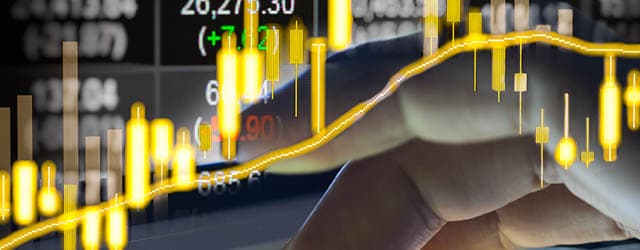Blockchain, the Cloud and the Internet of Things are luring trade finance away from its reliance on paper.

Back To Supplement
Trade finance is one area of commercial banking that historically has proven resistant to technological innovations. “It’s both ancient and arcane,” says Andy Schmidt, executive adviser with consulting firm CEB. As a niche within commercial banking, trade finance hasn’t seen the same pressure to modernize as have higher-volume areas like payments, he adds.
That is starting to change. As many trade finance transactions have migrated from traditional letters of credit to open-account transactions, companies and financial institutions have begun looking for other risk-mitigating options. One is the securitization of trade finance assets, says David Hennah, head of trade and supply chain finance at Misys, a provider of financial services software.
Corporate entities and the financial firms that serve them are also interested in streamlining the passage of information among the parties in trade finance transactions. The number of those parties can hit double digits, including shipping companies, freight forwarders, inspection companies, ports, customs agencies, tax authorities, banks and insurance companies, as well as the buyer and seller, points out Michael Vrontamitis, global head of trade in the transaction banking unit of Standard Chartered.
Blockchain And Distributed Ledger Technologies
To achieve these goals, financial institutions and financial technology companies are evaluating a number of technologies to deploy within the trade finance function. One is blockchain, which is a type of distributed database that stores a permanent and tamper-proof ledger of transaction data. In February, BNP Paribas announced that its first Blockchain Bizhackathon had assessed blockchain applications in several areas, including trade finance.
Also this year, Standard Chartered announced the successful completion of a proof of concept for the application of distributed ledger technology in trade finance invoicing.
“The challenge has been effectively being able to deliver an open-network solution [so] that all counterparties involved in the trade value chain can seamlessly pass information digitally between each other,” Vrontamitis says. “As technology has evolved, the ability to solve this problem has increased.”
Leveraging distributed ledger technology reduces the risk of duplicate invoice financing for banks, while preserving client confidentiality, Vrontamitis says. Double financing occurs when a company presents the same invoice for financing to two or more of its trade finance banks. Distributed ledger technology allows banks to enter their financed invoices on the blockchain and ensure no one else is financing them. “This is done without any impact to the bank’s customers and in a highly secure manner using blockchain,” he says.
“There is no doubt that a form of blockchain technology has a huge part to play
in trade finance in the future,” Dave Meynell and Gary Collyer, co-owners of www.tradefinance.training, wrote in response to emailed questions.
The Internet of Things
The Internet of Things can also play a role in trade finance. Embedding sensory and wireless technology within objects makes it possible to digitally transfer ownership of physical property, Meynell and Collyer explain. The technology also gives these objects the ability to transmit data about their identity, conditions and surrounding environment.

Another tool, the bank payment obligation, is “a valuable first step” in enabling the sharing of data among all parties in a supply chain, according to Meynell and Collyer. A BPO assures the seller’s bank that the buyer’s bank will pay on the due date, so the seller’s bank can proceed with financing, using the BPO as collateral, Hennah says. It addresses the need for risk mitigation, payment assurance, and/or financing services, he adds, and typically can be put in place quickly, easily and at a limited cost.
A BPO+ combines a BPO with other digital information, such as an electronic bill of lading. The electronic bill of lading is held in escrow pending a data match. When the match occurs, it’s released to the buyer. “You’re taking two digitized concepts, putting them together and creating a more compelling proposition,” Hennah says.
Electronic bills of lading will continue to grow in popularity, Meynell and Collyer predict. Such e-documents can reduce the delays that occur when mailing documents. Goods that arrive before a bill of lading can increase buyers’ costs, as they have to secure shipping guarantees, the consultants add.
Advances in business intelligence and data analytics can also benefit trade finance, Hennah says, given that banks are relying less on physical collateral and documents and more on information. Misys is investing in tools to extract business intelligence and consolidate data from multiple sources. The goal? “To leverage data analytics in a more predictive, versus descriptive, way,” he says.
Although it’s no longer considered new, Cloud technology too can play a role in trade finance. “People are spread around the world and have to access data,” says Kirk Lundburg, president and CEO of Trade Technologies, which provides trade payment software and services. Maintaining individual pockets of information behind firewalls doesn’t make sense.
Say an apparel manufacturer contracts with a factory in another part of the world to produce T-shirts. The factory sends the finished goods not to the apparel company itself, but to its distributors. Cloud-based software can let all parties see the transactions as they occur, so errors or holdups are spotted more quickly.
Private Clouds, which use a private IT infrastructure and are dedicated to a single organization, are one way to assuage security concerns, Lundburg says.
Fits and Starts
Even as financial firms and financial technology companies begin deploying various technologies in trade finance, progress likely will proceed in “fits and starts,” Lundburg believes. The reason? Transactions can only occur once all the buyers and sellers who are party to them agree to the changed procedures. Paper is expensive and unwieldy, but people are comfortable using it.
Companies may find it hard to persuade their trading partners to rely on technology, rather than a bank, for payment. “When you’re dealing with money, it’s a hard place to start,” Lundburg comments. He adds that although it’s likely technology will enter the trade finance function at some point, it first needs to be proven in other areas.
Internal organizational politics come into play. Say a company is selling into a foreign country and business is going well. The treasury team that might benefit from improving the trade finance process has to ask the sales team to change—and then get them to ask the customer to change. “They’re going to ask why,” Lundburg says. “It’s hard to get everyone on board to make the changes.”
A team from across various functions at Deutsche Bank examined the application of blockchain over several years. Team members decided the technology currently held the most potential, at least for now, in the securities area, says Edward Budd, chief digital officer for global transaction banking at Deutsche Bank: “We have to look at where we think the greatest impact would come, from a revenue, cost and risk perspective.”
Though the concerns and obstacles are real, a steady shift is likely. Budd expects to see “viable movement forward” in the application of technologies like distributed ledgers, blockchain and the Internet of Things over the next 18 months. “Adoption timelines, however, might vary, depending on if you look at securities, payments or trade finance products,” he adds.
The transition likely will lead to further collaboration between banks and fintechs, according to Meynell and Collyer. Corporates will benefit, they add, through “instantaneous decisions, paperless processing, mobile data input, review and authorization, new intermediaries, dynamic real-time operating models, and transparency.”
The paperless revolution has been a long time coming. At last, these technologies might make it a reality.



